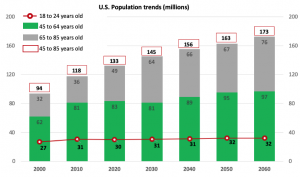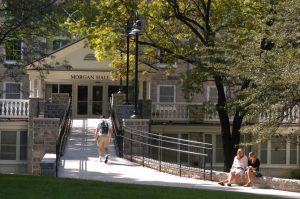
The number of Americans in the traditional college-age bracket will remain stable for the foreseeable future. Meanwhile the number of adults between 65 and 85 is predicted to increase from 49 million to 76 million. Even more important, the number of seniors in this age group who hold a Bachelors degree or higher will increase dramatically, from 8 million to 27 million.
Phase II of Dickinson+ — The Residences @ Dickinson — is a longer-term initiative that would involve development of a sustainable, LEED-gold residential campus on or adjacent to college property (most likely in partnership with a private developer) where alumni and other like-minded individuals could take up residence so as to fully immerse themselves in the life of the college. Having an integrated residential community on or near campus would also make it possible for the college to tap new revenue streams associated with that facility and its occupants.
The number of Americans in the traditional college student age bracket (18-24) will remain essentially flat at 32 million in the coming decades. Meanwhile, the number of retirement-age adults is predicted to increase substantially, from 49 million today to 76 million in 2060. Even more telling, only 18% of the current 65-and-older group (8 million Americans) have a Bachelor’s degree or higher. In 2060, 35% of that same age group (27 million) will have earned at least a Bachelors degree — a stunning 340% increase.
The anticipated increase in demand for college-related retirement communities is already leading to an increase in the number of these residential developments all around the country.[1] But most of these communities are not well integrated into the institutions of higher education they are contiguous with. As a result, nearby schools are capturing little if any potential benefit of having a community of active adult learners nearby. Just as importantly, these institutions are failing to fully develop any new revenue streams associated with these retirement communities.

The Morgan Hall Bridge (added in 2002) leads from the Morgan Field up to Morgan Hall’s renovated second-floor foyer.
Though much study and market analysis would need to be conducted in advance of any decisions to proceed with Phase II of Dickinson+, there are a number of interesting sites where such a development might be established.[2] One such site is the Allison Hall parking lot. Building on this particular site would have several advantages:
- Parking: Most of the current ground-level parking spaces could be retained for use by residents and students. This ground-level lot could then be tastefully enclosed in limestone to match the nearby campus buildings, with living space beginning on the second floor. Grade-level access to the campus could be made available via a bridge that matched the bridge that leads to the main second-floor entry of Morgan Hall (see picture at right).
- Acreage:The portion of the parking lot owned by Dickinson (see map below) is 120′ by 300′ (0.83 acres). For comparison purposes, the footprint of the new residence hall next to Malcolm Hall on High St. is approximately 120′ by 80′ (0.34 acres). The lot the Comfort Suites was built on in downtown Carlisle is approximately 60′ by 220′ (0.30 acres).
- Stormwater: If a residence were built over this existing parking lot, the building could be constructed without adding any stormwater runoff in the area.

Top: Waidner-Sparh library.
Below: Kline Fitness Center
This site also has excellent proximity to campus and community amenities (see map below). All of the following would be just a short walk away through one of the prettiest college campuses in the country:
- Dickinson School of Law (where resident’s might also be able to audit classes)
- Waidner-Spahr Library
- Kline fitness center
- The Trout Gallery and Rubenhdall Recital Hall
- The Alumni House @ Dickinson
- Bosler Hall (where most of the language courses are taught)
- Holland Union Building (book store, mail center, snack bar, events) and Mather Theatre
- Bosler Public Library
- Downtown shopping and restaurants
- Carlisle Theatre and Regional Performing Arts Center
- Carlisle Arts Learning Center
In sum, we all know that liberal arts colleges are at a crossroads. Perhaps 18% of all colleges like Dickinson have been found to be vulnerable to “critical strategic challenges.”[3] Only those institutions that rise to the challenge and take bold and yes, revolutionary steps to re-envision their business model will thrive in the long term. As such, Dickinson+ is more than a good idea for the college, it represents a strategic blueprint for Dickinson’s continued health and longevity.

- The Ithaca College/Longview Partnership between Ithaca College’s Gerontology Institute and Longview, a senior living community located less than a mile away from campus.
- Kendall at Hanover (NH), a senior living community integrated with Dartmouth College and located two miles away from campus.
- Lasell Village (Newton, MA), a senior living community affiliated with Lasell College and located one-half mile away from campus.
